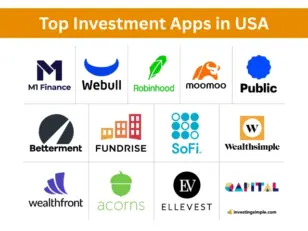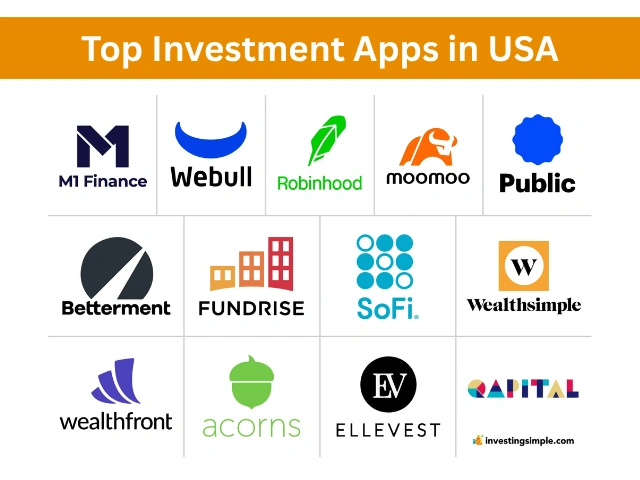Discover the top investment apps USA offers for beginners and experienced investors. Learn what investment apps are, their types, and how they simplify investing.
In today’s digital age, investing has become easier than ever with mobile applications. Investors no longer need to visit brokerages or spend hours analyzing stocks manually. Instead, investment apps USA provide a convenient platform to manage portfolios, track investments, and even receive personalized advice. These apps are transforming the way Americans invest, making it accessible to beginners and experienced traders alike. With thousands of apps available, understanding which platforms offer reliability, security, and useful features is essential for maximizing returns. Whether you want to invest in stocks, ETFs, mutual funds, or cryptocurrencies, there’s an app tailored to your needs.
What Are Investment Apps?
An investment app is a mobile or web-based application that allows users to buy, sell, and manage investments directly from their smartphones or computers. These apps provide tools, analytics, and insights to make investing easier, faster, and more efficient.
Key Features of Investment Apps:
- Real-Time Trading: Buy and sell stocks, ETFs, and funds instantly.
- Portfolio Tracking: Monitor performance, gains, and losses.
- Educational Resources: Tutorials, articles, and investment tips for beginners.
- Low Minimum Investment: Many apps allow users to start with as little as $1.
- Automation: Robo-advisors and auto-investing options.
Investment apps are especially popular among younger investors who prefer managing money on-the-go while enjoying user-friendly interfaces and low fees.
Types of Investment Apps
1. Stock Trading Apps
- Allow users to trade individual stocks, ETFs, and options.
- Examples: Robinhood, Webull, E*TRADE.
2. Robo-Advisors
- Automatically invest funds based on your risk profile and goals.
- Examples: Betterment, Wealthfront.
3. Mutual Fund Apps
- Focus on mutual fund investments with options for SIPs and reinvestment.
- Examples: Vanguard, Fidelity.
4. Hybrid Apps
- Provide multiple investment options including stocks, ETFs, mutual funds, and sometimes crypto.
- Examples: SoFi, Acorns.
5. Cryptocurrency Investment Apps
- Allow buying, selling, and tracking digital assets like Bitcoin and Ethereum.
- Examples: Coinbase, Binance US.
These apps cater to different investment styles, risk tolerance, and levels of experience, making it essential to choose the right type for your financial goals.
Features to Look for in Investment Apps
When choosing the best investment apps USA, it’s essential to consider features that ensure ease of use, security, and potential for growth. Here are the top features to look for:
1. User-Friendly Interface
- The app should be easy to navigate, especially for beginners.
- Clear dashboards, charts, and analytics help make informed decisions.
2. Low Fees and Commissions
- Check for trading fees, management fees, and hidden charges.
- Many apps now offer zero-commission trading for stocks and ETFs.
3. Security and Regulation
- Ensure the app is regulated by FINRA or SEC.
- Features like two-factor authentication and encryption safeguard your funds and personal data.
4. Investment Options
- Apps that offer multiple investment types (stocks, ETFs, mutual funds, crypto) provide flexibility.
- Consider your investment goals and whether the app supports them.
5. Educational Resources
- Look for apps offering tutorials, articles, and market news to enhance knowledge.
6. Automation Tools
- Robo-advisors and auto-investing features help beginners invest consistently without manual intervention.
Top Stock Trading Apps in the USA
- Robinhood
- Commission-free trading for stocks, ETFs, and options
- Beginner-friendly interface
- Offers fractional shares
- Webull
- Advanced charting and research tools
- Commission-free stock and ETF trading
- Ideal for intermediate to advanced traders
- E*TRADE
- Wide range of investment options including stocks, ETFs, and mutual funds
- Robust educational resources for beginners
- User-friendly mobile app and web platform
Top Robo-Advisors in the USA
- Betterment
- Automatically manages investments based on your risk profile
- Low fees and goal-based planning
- Tax-loss harvesting for optimized returns
- Wealthfront
- Provides automated portfolio management
- Offers 529 college savings plans and retirement planning
- Ideal for beginners seeking passive investing
- SoFi Invest
- Hybrid platform for both active trading and automated investing
- No management fees for automated portfolios
- Additional benefits like financial planning and student loan tools
Top Mutual Fund & ETF Apps in the USA
Investors focused on long-term growth often prefer apps specializing in mutual funds and ETFs. Here are the top options:
1. Vanguard
- Offers a wide range of low-cost mutual funds and ETFs
- Strong reputation for reliability and performance
- Ideal for long-term investors and retirement planning
2. Fidelity
- Provides mutual funds, ETFs, and retirement accounts
- Powerful research tools and educational resources
- Suitable for both beginners and experienced investors
3. Charles Schwab
- Offers commission-free ETFs and a variety of mutual funds
- Intuitive platform for portfolio management
- Strong customer support and educational content
4. TD Ameritrade
- Mutual fund screener and ETF research tools
- Access to both active and passive investment options
- Educational webinars and tutorials for new investors
Comparison Between Popular Investment Apps
| Feature | Robinhood | Webull | Betterment | Vanguard | Fidelity | Schwab |
| Type | Stock/ETF | Stock/ETF | Robo-Advisor | Mutual Fund/ETF | Mutual Fund/ETF | Mutual Fund/ETF |
| Fees | $0 | $0 | 0.25%-0.40% | Low | Low | Low |
| Automation | Limited | Limited | Yes | Limited | Limited | Limited |
| Best For | Beginners, active trading | Intermediate traders | Passive investors | Long-term investors | Diversified investors | Long-term investors |
This comparison helps investors choose apps based on trading style, cost, and investment goals.
Pros and Cons of Using Investment Apps
Pros
- Accessibility: Invest anytime from your phone
- Low Minimum Investment: Start with small amounts
- Ease of Use: Simple interfaces and step-by-step guidance
- Diverse Options: Stocks, ETFs, mutual funds, crypto, and more
- Automation: Robo-advisors help invest consistently
Cons
- Overtrading Risk: Easy access can lead to frequent buying/selling
- Limited Human Advice: Some apps lack personal financial advisors
- Technical Issues: App downtime or glitches can affect trading
- Fees for Advanced Features: Some platforms charge for premium tools or research
Tips for Choosing the Right Investment App
Selecting the right investment app USA depends on your goals, experience, and trading style. Here are some practical tips:
1. Identify Your Investment Goals
- Are you saving for retirement, building wealth, or trading stocks?
- Different apps specialize in long-term investing, active trading, or automated portfolios.
2. Consider Fees and Commissions
- Look for apps with low fees to maximize returns.
- Check management fees, trading commissions, and hidden charges.
3. Check Security and Regulation
- Ensure the app is regulated by FINRA or SEC.
- Look for two-factor authentication, encryption, and FDIC or SIPC insurance for funds.
4. Evaluate User Experience
- The app should have an intuitive interface and easy-to-read dashboards.
- Reviews and ratings can help determine usability.
5. Research Available Investment Options
- Ensure the app supports the assets you want to invest in (stocks, ETFs, mutual funds, crypto).
- Consider features like fractional shares, automated investing, and research tools.
Common Mistakes to Avoid
- Overtrading – Frequent buying and selling can increase fees and reduce returns.
- Ignoring Fees – High commissions or management fees can eat into profits.
- Neglecting Research – Relying solely on app recommendations without personal research.
- Not Diversifying – Putting all funds into one stock, ETF, or mutual fund increases risk.
- Chasing Quick Gains – Short-term trends can be risky; focus on long-term growth.
FAQs About Investment Apps USA
1. Are investment apps safe?
- Yes, if the app is regulated, uses encryption, and provides insurance like SIPC protection.
2. Can beginners use these apps?
- Absolutely. Many apps are beginner-friendly and offer educational resources.
3. Do I need a lot of money to start investing?
- No, many apps allow starting with as little as $1 or $50.
4. Are investment apps free?
- Most have free versions; some charge fees for premium tools or advanced features.
5. Can I combine multiple apps in my portfolio?
- Yes, using multiple apps can provide diversification and access to different features.
Conclusion
Investment apps have revolutionized the way Americans invest, making it easier to start, track, and grow your portfolio. By understanding the features, benefits, and potential drawbacks, investors can choose the best investment apps USA for their needs.
Key Takeaways:
- Choose apps based on goals, fees, security, and usability.
- Diversify across assets to reduce risk.
- Use automation tools like robo-advisors for consistent investing.
- Avoid overtrading and focus on long-term wealth creation.
With the right investment app, beginners and experienced investors alike can build a robust financial future while enjoying convenience and accessibility.

